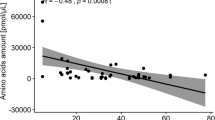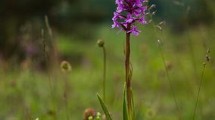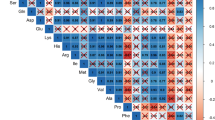Abstract
Approximately 1 500 angiosperm species, in previous papers, have been sampled for the assessment of the amino acids (a. a.) in their nectar. We reaffirm that the findings provide statistically significant data linking differences in the concentration with pollinator type. Flowers that are pollinated by animals that have alternative sources of protein-building a. a.’s show lower a. a. concentration than those that are not. There is a tendency for woody plant nectar a. a.’s to be less concentrated than those of herbaceous plants, but there can be “phylogenetic constraints” which may reduce the correlations of a. a. concentration with pollinator type and with life form. The individual a. a.’s form complements which are qualitatively extremely constant within species. Proline is a normal constituent of many nectars and does not necessarily indicate contamination of the nectar by pollen. Criticism of our findings byGottsberger & al. (1984) is answered by reference to our previous publications and those of other workers, and to the presentation of data from California native species, not published previously. All previous postulates are borne out by these new data with the exception of positive correlations of a. a. concentration with “primitive” and “advanced” floral characteristics taken one at a time, which appear to be inconsistent and are affected strongly by the nature of the family in which they occur. Summary data are provided for families and genera which indicate that high or low a. a. concentration can typify certain families and genera of both relatively “primitive” and relatively “advanced” nature. Needs for future research on an ecosystem basis are quoted.
Similar content being viewed by others
References
Baker, H. G., 1975: Sugar concentrations in nectars from hummingbird flowers. — Biotropica7, 37–41.
—— 1977: Non-sugar constituents of nectar. — Apidologie8, 349–356.
—— 1978: Chemical aspects of the pollination biology of woody plants in the tropics. — InTomlinson, P. B., Zimmermann, M. H., (Eds.): Tropical Trees as Living Systems, 57–82. — Cambridge: University Press.
——, 1973a: Some anthological aspects of the evolution of nectar-producing flowers, particularly amino acid production in nectar. — InHeywood, V. H., (Ed.): Taxonomy and Ecology, 243–264. — London: Academic Press.
—— —— 1973b: Amino acids in nectar and their evolutionary significance. — Nature241, 543–545.
—— —— 1975: Studies of nectar constitution in pollinator-plant coevolution. — InGilbert, L. E., Raven, P. H., (Eds.): Co-evolution of Animals and Plants, 100–140. — Austin: Univ. of Texas Press.
—— —— 1977: Intraspecific constancy of floral nectar amino acid complements. — Bot. Gaz.138, 183–191.
—— —— 1982: Chemical constituents of nectar in relation to pollination mechanisms and phylogeny. — InNitecki, H. M., (Ed.): Biochemical Aspects of Evolutionary Biology, pp. 131–171. — Chicago: Univ. Press.
—— —— 1983a: A brief historical review of the chemistry of floral nectar. — InBentley, B., Elias, T., (Eds.): The Biology of Nectaries, 126–152. — New York: Columbia Univ. Press.
—— —— 1983b: Floral nectar constituents in relation to pollinator type. — InJones, C. E., Little, R. J., (Eds.): Handbook of Experimental Pollination Biology, 117–141. — New York: Van Nostrand-Reinhold.
——, 1978: A comparison of the amino acid complements of floral and extrafloral nectar. — Bot. Gaz.139, 322–332.
Baker, I., Baker, H. G., 1976a: Analyses of amino acids in flower nectars of hybrids and their parents, with phylogenetic implications. — New Phytol.76, 87–98.
—— —— 1976b: Analysis of amino acids in nectar. — Phytochem. Bull.9, 4–7.
—— —— 1979: Chemical constituents of the nectars of twoErythrina species and their hybrids. — Ann. Missouri Bot. Gard.66, 446–450.
—— —— 1982: Some chemical constituents of floral nectars ofErythrina in relation to pollinators and systematics. — Allertonia3, 25–38.
Freeman, C. E., Reid, W. H., Zaun, J. W., 1983: Nectar amino acids in four species ofAgave (Agavaceae). — Southwestern Naturalist28, 113–114.
Gilliam, M., McCaughey, W. F., Moffett, J. O., 1981: Amino acids in the floral nectar of cotton. — Apidologie12, 125–132.
—— ——, 1980: Aminoacids in pollens and nectars of citrus cultivars and in stored pollen and honey from honeybee colonies in citrus groves. — J. Apicultural Res.19, 64–72.
Gottsberger, G., Schrauwen, J., Linskens, H. F., 1984: Amino acids and sugars in nectar, and their putative evolutionary significance. — Pl. Syst. Evol.145, 55–77.
Hanny, D. W., Elmore, C. D., 1974: Amino acid composition of cotton nectar. — J. Agric. Food Chem.22, 476–478.
Merrill, E. D., 1954: The Botany of Cook’s Voyages. — Chronica Botanica14 (5/6), 171–384. — Mass.: Waltham.
Rust, R. W., 1977: Pollination inImpatiens pallida (Balsaminaceae). — Bull. Torrey Bot. Club104, 361–367.
Yorks, P. F., 1979: Chemical Constitution of Nectar and Pollen in Relation to Pollinator Behavior in a California Ecosystem. — 1–203. Ph.D. thesis, Univ. of California, Berkeley.
Author information
Authors and Affiliations
Rights and permissions
About this article
Cite this article
Baker, H.G., Baker, I. The occurrence and significance of amino acids in floral nectar. Pl Syst Evol 151, 175–186 (1986). https://doi.org/10.1007/BF02430273
Received:
Issue Date:
DOI: https://doi.org/10.1007/BF02430273




